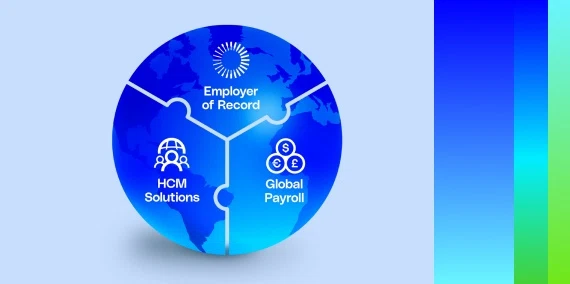G-P and Frost & Sullivan are aligned in their missions to guide the world’s top companies toward transformational growth. In the first segment of this webinar, Melanie Turek, Senior Fellow and Vice President of Consulting at Frost & Sullivan, and Dev Das, Vice President of Customer Experience and Operations at G-P, sat down to talk about the key benefits and challenges of the hybrid workplace.
Whether you’re scaling back or scaling up, facing headwinds or tailwinds, organizations need to be both agile and resilient. An Employer of Record (EOR) unlocks that ability, allowing companies to hire highly skilled talent anywhere in the world and enter new markets quickly, regardless of entity status.
But as HR leaders know, managing global teams in hybrid and remote work environments comes with benefits and challenges.
Defining the hybrid work model
“As you’re profiling candidates, [ask yourself] what are the markers for people to come in and be successful in the version of hybrid that you have at your company.”
One of the common pitfalls of the hybrid model is setting unclear expectations.. In many cases, people have begun to build their lives around remote working, and disrupting that can cause some to reevaluate their role at the company.
Different roles may require different versions of hybrid, so it’s important for companies to evaluate each situation rather than putting a blanket definition of hybrid over every position. This can depend on travel requirements, level of customer interaction, or the need to be physically present for key meetings or events. The more clarity around what hybrid work looks like for a specific role, the better.
Challenges of a global hybrid workplace
“In this new hybrid environment, thinking about the cost of labor across different roles and geographies becomes a critical enabler to getting the right talent.”
The recruitment process differs in a hybrid workplace from that of a traditional office workplace. As mentioned above, the most important thing is being clear about the expectations for hybrid employees. But once that has been established, a new world of potential candidates opens up.
A global hybrid model is now attainable for companies, providing flexibility that ranges from having some people at the office to having others based in a completely different country. However, with that comes the complexities of adjusting compensation structures to match each target region, and navigating internal equity in terms of the cost of labor vs. cost of location.
Then businesses have to evaluate if a potential hire is right for a hybrid role. As candidates are profiled, it’s important to gauge how they respond to virtual work environments. Can they collaborate, create relationships, get work done, and be effective in that sort of environment? Everyone is different and has unique work styles and preferences, so it’s crucial to vet that out in the recruitment process.
The best talent anywhere in the world is accessible, particularly thanks to Employer of Record solutions.
Onboarding global hybrid employees
“A lot of folks aren’t actually accessing things from anything but a mobile device in certain regions of the world, so you need to make sure that your content and your training and your onboarding is all ready for that.”
In a hybrid work environment, organizations must ensure new hires have all the resources they need to feel supported and integrated into the team. This is especially true for global employees as companies navigate challenges that go beyond corporate culture.
One example of this is making information accessible in a variety of mediums and formats. Companies have to rethink how they’re offering learning experiences, and enable employees to learn in ways that resonate with their cultural context.
Another important consideration is the standardization of the onboarding process, which gives companies the opportunity to provide a more consistent employee experience across company norms, culture, communication tools, diversity and inclusion initiatives, and other key topics.
Employee engagement in a global hybrid workplace
“Cultural awareness, norm setting, and bringing diversity and inclusion even more front and center in everyday interactions become so important because there’s much more cross-cultural, cross-time zone, cross-team work happening now.”
Some team members may love an afternoon lunch-and-learn on video, others may love an after-work event. By offering different types of engagement formats, you can figure out what resonates with your global employees.
Additionally, staying open to different strategies and communication methods is important to keeping employees engaged. Let employees know it’s OK to go on a walk while attending a one-on-one, or have their camera off in a meeting while they walk their dog. These kinds of experiences can help keep employees engaged and drive retention.
Finding the right balance in a hybrid work model
Navigating a hybrid work model can be difficult at times. It comes with challenges like rethinking the recruitment and onboarding process and implementing more flexible communication and work styles. It also provides new opportunities like hiring beyond a limited radius and enriching the diversity, culture, and talent of an organization. Achieving the right balance is possible, and can lead to an engaged and motivated workforce and a mutually beneficial relationship between employer and employee.
For more insights on engaging talent, embracing change, and uncovering the value of an Employer of Record, watch the full webinar.
—
G-P and Frost & Sullivan share a common goal of guiding the world’s top companies toward global expansion and global success. Frost & Sullivan’s Growth Pipeline as a Service (GPaaS) value proposition allows customers to maximize their economic potential, navigate emerging megatrends, and shape a future based on sustainable growth.
G-P’s industry-leading Employer of Record (EOR) solutions and global employment products help companies plan, hire, and manage global teams in 180+ countries, without setting up new entities. Stay tuned as we continue to lead the conversation around the future of work and the path to global growth with insightful conversations like these.










